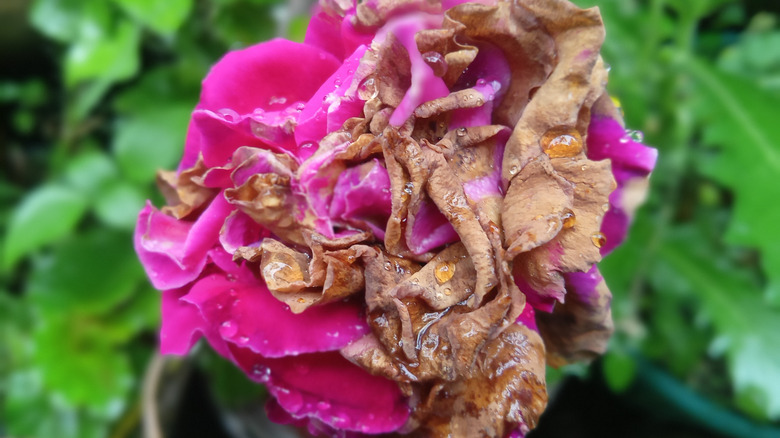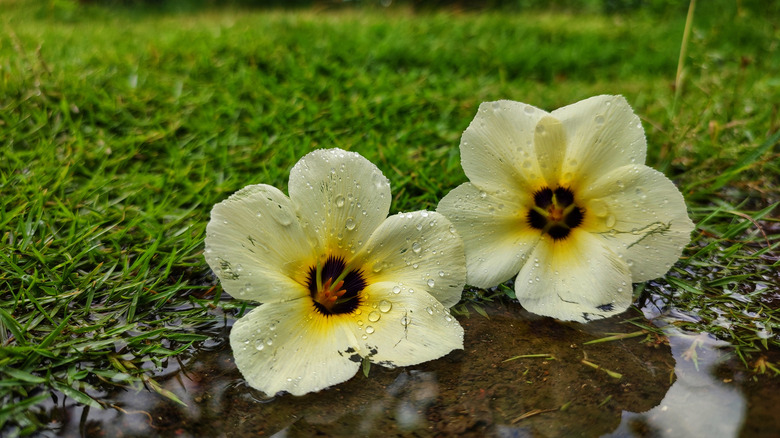What Gray Mold On Flowers Really Means (And How To Fix It)
Imagine taking a stroll through your garden to gaze at your pretty flowers, only to discover they are covered with a fuzzy gray coating. This could be pretty disheartening, especially when you have worked so hard to have your flower beds bursting with color. Not only does this fuzzy gray mold look extremely unsightly on flowers, but it is a serious fungal infection that can kill the affected petals and, with time, the entire flower.
Gray mold, also known as Botrytis blight, starts quietly. It first shows up on petals, leaves, or stems of flowers as small, water-soaked, light brown spots. These spots, however, later enlarge, become irregular, and get covered with masses of spores. The infection is caused by the fungus Botrytis cinerea, which affects a wide range of ornamental plants, including geranium, zinnia, and many others. Also, it doesn't spare any parts of the plant.
Tender tissues like flower petals, young seedlings, and fresh buds are at the most risk. And, give it a spell of cool, damp weather, and it spreads like wildfire. Managing Botrytis can be tricky. It quickly invades host plants and releases a ton of spores that move through the air. Still, with the right know-how and the right approach, you can keep this and other types of fungi from taking over your garden.
Why is gray mold so common, and what helps it thrive?
Most Botrytis species thrive on a narrow range of hosts, but the fungus behind gray mold, i.e., Botrytis cinerea, can infect over 1400 species. But what makes it so successful? Understanding its life cycle, survival tactics, and the conditions that help it thrive can help you keep it in check. The fungus thrives in cool, damp conditions, especially in gardens that are crowded, shaded, and lacking good air circulation. Weeds and leftover plant debris often harbor gray mold.
The spores released from there, once airborne, can grow on nearly any moist or decaying plant material. However, their germination on plants occurs most often in certain conditions. For instance, plant surfaces that stay wet for several hours are practically an open invitation for Botrytis. Other critical factors that help it spread include humidity exceeding 93% and temperatures hovering between 55 and 65 degrees Fahrenheit. Also, watch out for plant injuries.
The fungus sometimes sneaks in through wounds into the plants. Even overfertilizing can wound plant tissues, making it easier for gray mold to take hold. This combination of moisture, temperature, along with a wide range of hosts, high reproductive output, and flexible infection mode, allows gray mold to thrive in gardens.
How to fix gray mold in the garden and prevent it in the future?
Since gray mold spreads quickly and is extremely destructive, you need to be quick, too. Start by carefully removing and disposing of infected petals, leaves, and stems to halt spore production. Never compost diseased plants. Also, don't skip cleaning your tools after pruning! Botrytis spores can easily hitch a ride on blade surfaces and may get transferred to healthy plants. So make sure to wipe your tools down with 70% alcohol or soak them in a 10% bleach solution once you have removed any infected parts. To prevent future infestation, you can use fungicides such as chlorothalonil and mancozeb.
But in most cases, they are not really necessary. Good cultural practices alone are usually enough to keep gray mold under control and at manageable levels. Moisture control is your best defense against gray mold. Also, once conditions dry out, many flowering plants can bounce back on their own. Good airflow is another thing that can help. So, give your plants enough space, trim back thick clusters, and get rid of any still, "dead air" areas so leaves don't stay wet for too long.
In addition, remove dead flowers, leaves, and debris regularly. Lastly, avoid overhead watering and practices that leave plants moist overnight or for a long time. If possible, use drip irrigation or invest in some good irrigation systems for your flower beds.


